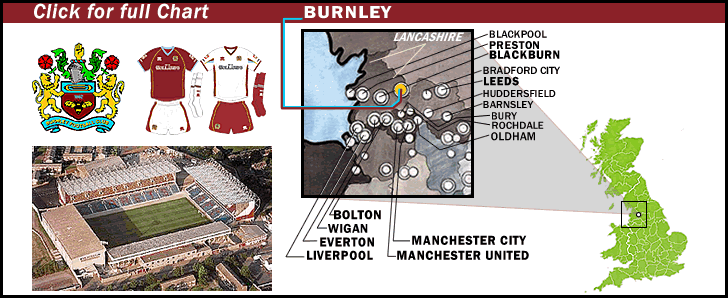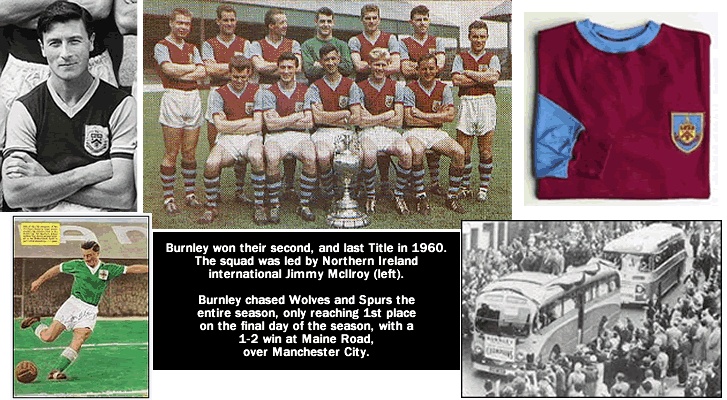Please note: there is a recent post that has info on the 2015-16 Burnley FC…click on the following,
2016–17 Premier League (1st division England, including Wales – location-map with chart: 14/15-&-15/16-crowds-&-finish + titles-&-seasons-in-1st-division./+ the 3 promoted clubs for 2016-17 (Burnley, Middlesbrough, Hull City AFC).
…
Burnley FC were one of the founding members of the English Football League. The club started out as a rugby football team, but switched to association football in May, 1882. The club moved to the Turf Moor ground in 1883, and have been there ever since. They helped form the Football League, with 11 other clubs, on 17 April, 1888 {see this}. Burnley spent 9 seasons in the First Division, before being relegated in 1897. They bounced right back up in 1898, but were relegated again 2 seasons later (1900).
Burnley spent 13 seasons in the Second Division, before gaining promotion in the spring of 1913. By this time, the club had switched to the claret and sky-blue kit that they have worn ever since (except for 4 seasons in the late 1930s, when they wore white jerseys and black pants). They switched to the claret and blue, in 1910, in emulation of the successful Aston Villa FC. This was done at the suggestion of their new manager, John Haworth. Burnley had hired the Accrington secretary Haworth in 1910. {See this article on John Haworth, from the Clarets-Mad site.} The young and untried Haworth made some good signings, including Bert Freeman, from Everton {see this article, from the Clarets-Mad website}. 3 years in, Haworth led the Lancashire club back to the First Division.
Burnley finished in 12th place their first season back in the top flight ((1913-14). The club had a strong cup run that season, making it all the way to th 1914 FA Cup Final. At the old Crystal Palace {see this}, Burnley defeated Liverpool, 1-0, with the winning goal scored by Bert Freeman, in the 58th minute. The Cup was presented to the winners by King George V. This was the first time the reigning monarch had done so, and it was an indication of how prominent in the English cultural landscape the FA Cup (and football itself) had become.
[The two kits above are copyright Historical Football Kits, and are reproduced by permission.]
The following season (1914-15), Burnley finished in 4th place. The Great War (World War I) interrupted play from 1915-1919. When play resumed, for the 1919-20 season, Burnley finished in 2nd place, 9 points behind champions West Bromwich Albion. The following season (1920-21) Burnley lost its first three matches, but then went on a 30-game unbeaten run. They went on to win the National Title, 4 points clear of 2nd place Manchester City. This unbeaten streak lasted as a record for 83 years, until 2004, when it was broken by Arsenal.
Haworth set about rebuilding the aging Burnley side in the aftermath of the club’s championship. Burnley finished in 3rd the following season (1921-22), but fell to 15th place in 1923. Sadly, Howarth died in December, 1924, of pneumonia, at the age of 48. Burnley stayed near the bottom of the table for 6 of the next 7 seasons, and were relegated in the spring of 1930.
Burnley spent all the 1930s, and the first season after World War II (1946-47) in the Second Division. They were promoted in 1947, under manager Cliff Britton. That same season, Burnley made it all the way to the FA Cup Final, but they lost to Charlton, 0-1, in extra time.
Back in the First Division, and enjoying the post-War surge in attendance, Burnley had its peak season at the turnstiles in the 1947-48 season, averaging 33,621. Throughout most of the next two decades (1949-’69), Burnley would average between 20 and 27,000 per game (but by 1970, their gate had shrunk to around 16,000).
Burnley finished an impressive 3rd their first season back in the First Division (1948), but fell to 15th the next season. From 1950 to 1959, the club averaged an 8th place finish, with 6th place the best (twice) and 14th place worst.
In February, 1958, Burnley hired Shrewsbury manager Harry Potts {see this}. The squad at this time was centered around the duo of midfielder Jimmy Adamson {see this} and inside forward Jimmy McIlroy {see this}. The 1959-’60 season was characterized by a 3-way race for the Title, between Tottenham, Wolverhampton, and Burnley. The Clarets trailed Wolves and Spurs the entire campaign, only reaching first place on the final day of the season, with a 1-2 victory at Manchester City. Goals were scored by Brian Pilkington and Trevor Meredith.
The next season (1960-61), Burnley finished in 4th place. That season, the club played in the European Cup for the first time, beating Reims of France, before bowing out to Hamburg, of Germany.
The 1961-62 season saw Burnley almost win the double, only to come up short in the League (2nd place, 3 points behind champs Ipswich Town) and the FA Cup Final (a 1-3 loss to Tottenham Hotspur). A 3rd place finish in 1963 showed that Burnley was in the upper echelon of English football in the first half of the 1960′s. However, their time near the top of the table was about to end. McIlroy had been transferred to Stoke City in ’62 (to the ourage of Burnley supporters), and Adamson retired in ’64, and Burnley was unable to build a successful new nucleus. Although the club finished in 3rd place in 1966, four straight finishes of 14th place followed (1967 through 1970). And in 1971, they were relegated.
Jimmy Adamson had returned to the club as manager, in 1970, and he was able to guide Burnley back to the top flight, in 1973, after a 2 year spell in the Second Division. But despite a respectable 6th place finish the next year (’74), the club were relegated again, in 1976.
Burnley has not been in the first division since then. Since 1976, the Clarets have spent 14 seasons in the 2nd Level, 11 seasons in the 3rd Level, and 7 seasons in the 4th Level. Their low point was the 1986-’87 season, when a final day win versus Leyton Orient, coupled with a Lincoln City loss, was the only thing that kept Burnley from being relegated out of the League.
Burnley made it back to the second tier in 2000. Two straight seasons finishing in 7th place followed, but for the last four seasons, they have finished no higher than 13th place. Lack of funds have kept the club from fielding a squad deep enough to withstand the rigors of second division football, and a late season fade had become their unwanted trademark. That is until this season. Manager Steve Cotterill had augmented leading goal scorer Andy Gray with a number of Premier League veterans, including goalkeeper Gabor Kiraly, defender David Unsworth, and forward Ade Akinbiyi. However, an uninspiring run of form led Cotterill to depart, by mutual consent, in November ’07.
Cotterill was replaced by Scotsman Owen Coyle {see this}, who came over from second tier Scottish club St Johnstone. Since Coyle’s arrival, Burnley have begun playing an attractive style of attacking football, and have risen up the table. The club sold Gray to Charlton in the January 2008 transfer window (for 1.5 to 2 million pounds, depending on appearances); and they brought in veteran goal-machine Andy Cole.
Striker Robbie Blake leads the club with 8 league goals (9 overall); Akinbiyi has 7 league goals (8 overall). During the transfer window, Burnley refused multi-million pound bids from both Celtic and Rangers for their Northern Ireland international Kyle Lafferty (a 6′ 4” midfielder/striker) {see this}. This is a good indication that the club is serious about their promotion push.
Burnley drew away to Stoke City, 1-1, last Saturday (with a goal by Lafferty), and beat Charlton 1-0, on Tuesday (with a goal by Wade Elliot). That’s two straight clubs in the playoff places that Burnley were able to handle. And now, Burnley sit just 2 points shy of the playoff places, themselves, in 8th place. Owen Coyle’s squad has the second best road record in the league (behind Watford), and show no sign of faltering down the stretch..
Thanks to (historical kits[dot]co[dot]uk): the 8 older kits on the right hand side of the chart are copyright Historical Football Kits, and are reproduced by permission. Thanks to (colours-of-football[dot]com); (stadiumguide[dot]co[dot]uk); (viewimages[dot]com); (fa-cupfinals[dot]co[dot]uk); (webbaviation[dot]co[dot]uk); Northern Ireland Football Greats website (nifg[dot]co[dot]uk.



